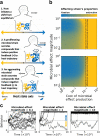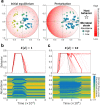Evolutionary modeling suggests that addictions may be driven by competition-induced microbiome dysbiosis
- PMID: 37495841
- PMCID: PMC10372008
- DOI: 10.1038/s42003-023-05099-0
Evolutionary modeling suggests that addictions may be driven by competition-induced microbiome dysbiosis
Abstract
Recent studies revealed mechanisms by which the microbiome affects its host's brain, behavior and wellbeing, and that dysbiosis - persistent microbiome-imbalance - is associated with the onset and progress of various chronic diseases, including addictive behaviors. Yet, understanding of the ecological and evolutionary processes that shape the host-microbiome ecosystem and affect the host state, is still limited. Here we propose that competition dynamics within the microbiome, associated with host-microbiome mutual regulation, may promote dysbiosis and aggravate addictive behaviors. We construct a mathematical framework, modeling the dynamics of the host-microbiome ecosystem in response to alterations. We find that when this ecosystem is exposed to substantial perturbations, the microbiome may shift towards a composition that reinforces the new host state. Such a positive feedback loop augments post-perturbation imbalances, hindering attempts to return to the initial equilibrium, promoting relapse episodes and prolonging addictions. We show that the initial microbiome composition is a key factor: a diverse microbiome enhances the ecosystem's resilience, whereas lower microbiome diversity is more prone to lead to dysbiosis, exacerbating addictions. This framework provides evolutionary and ecological perspectives on host-microbiome interactions and their implications for host behavior and health, while offering verifiable predictions with potential relevance to clinical treatments.
© 2023. The Author(s).
Conflict of interest statement
The authors declare no competing interests.
Figures




Similar articles
-
The Roles of Inflammation, Nutrient Availability and the Commensal Microbiota in Enteric Pathogen Infection.Microbiol Spectr. 2015 Jun;3(3). doi: 10.1128/microbiolspec.MBP-0008-2014. Microbiol Spectr. 2015. PMID: 26185088
-
Gut microbiome and non-alcoholic fatty liver disease.Prog Mol Biol Transl Sci. 2022;191(1):187-206. doi: 10.1016/bs.pmbts.2022.07.004. Epub 2022 Aug 22. Prog Mol Biol Transl Sci. 2022. PMID: 36270678
-
Homeostasis and dysbiosis of the gut microbiome in health and disease.J Biosci. 2019 Oct;44(5):117. J Biosci. 2019. PMID: 31719226 Review.
-
Resilience of the Oral Microbiota in Health: Mechanisms That Prevent Dysbiosis.J Dent Res. 2018 Apr;97(4):371-380. doi: 10.1177/0022034517742139. Epub 2017 Dec 1. J Dent Res. 2018. PMID: 29195050 Review.
-
Review: modulation of the oral microbiome by the host to promote ecological balance.Odontology. 2019 Oct;107(4):437-448. doi: 10.1007/s10266-019-00413-x. Epub 2019 Feb 4. Odontology. 2019. PMID: 30719639 Free PMC article. Review.
Cited by
-
Little Peacemakers: Microbes Can Promote Nonviolent Conflict Resolution by Their Hosts.Ecol Evol. 2025 Apr 16;15(4):e71129. doi: 10.1002/ece3.71129. eCollection 2025 Apr. Ecol Evol. 2025. PMID: 40242803 Free PMC article.
-
Probiotics-role in alleviating the impact of alcohol liver disease and alcohol deaddiction: a systematic review.Front Nutr. 2024 Aug 30;11:1372755. doi: 10.3389/fnut.2024.1372755. eCollection 2024. Front Nutr. 2024. PMID: 39290562 Free PMC article.
-
Addictive Behavior and Evolutionary Adaptation: Mitigated through Genetic Addiction Risk Severity Early Identification and Awareness Integration Theory.Med Res Arch. 2024 Aug;12(8):10.18103/mra.v12i8.5702. doi: 10.18103/mra.v12i8.5702. Epub 2024 Aug 30. Med Res Arch. 2024. PMID: 39610915
-
The interaction between problematic internet use, diet quality, and disordered eating risk in adolescents: a mediation and network analysis.Eat Weight Disord. 2025 Aug 4;30(1):61. doi: 10.1007/s40519-025-01774-9. Eat Weight Disord. 2025. PMID: 40759827 Free PMC article.
References
-
- Hedegaard, H., Miniño, A. M., Spencer, M. R. & Warner, M. Drug overdose deaths in the United States, 1999–2020. (2021). - PubMed

